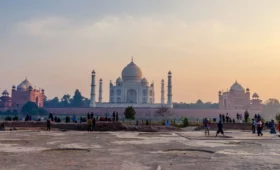The Best Season to Visit the Majestic Taj Mahal
The Taj Mahal, an architectural masterpiece and a symbol of eternal love, stands as a testament to the grandeur of Mughal art and history. Situated in the city of Agra, India, this magnificent white marble monument attracts millions of visitors from across the globe every year. While the Taj Mahal is a sight to behold year-round, there are certain seasons when a visit can be particularly enchanting. Let’s explore the best seasons to plan your visit to this iconic wonder.
![]()

- Winter (October to March):
The Optimal Time for Most Travelers
Winter is arguably the best time to visit the Taj Mahal, and for good reason:
- Pleasant Weather: The weather during these months is cool and comfortable, making it ideal for exploring the monument and the surrounding gardens. You’ll avoid the scorching heat of the Indian summer.
- Fog-Free Views: Winter brings clear skies and minimal fog, ensuring you can admire the Taj Mahal’s stunning beauty without obstruction. The early morning view during sunrise is particularly breathtaking.
- Festive Atmosphere: Agra experiences several cultural festivals and events during the winter months, which can add an extra layer of excitement to your visit.
- Photography Conditions: The soft, diffused light during winter enhances the beauty of the Taj Mahal, making it the perfect time for photographers.
“Explore the timeless beauty of the Taj Mahal with our curated tour packages. Witness the iconic monument’s grandeur and history. Book your same day Taj Mahal tour today!”
- Spring (March to April):
For Those Who Prefer Mild Temperatures
Spring in Agra offers pleasant weather, with temperatures gradually warming up. This season can be a good choice for those who prefer milder temperatures but don’t mind a bit of warmth. The gardens surrounding the Taj Mahal are in full bloom, adding an extra layer of charm to your visit.
- Early Autumn (September):
Ideal for Avoiding Crowds
September marks the beginning of the post-monsoon season in India. While temperatures can still be relatively high, this month is a good option for avoiding the large crowds that typically visit the Taj Mahal during the peak tourist season. The monument and its surroundings are less crowded, allowing for a more peaceful and intimate experience.
- Monsoon (July to August):
For Those Seeking a Unique Experience
Monsoon season in Agra brings lush greenery and a fresh, rejuvenating ambiance. While the rain can be unpredictable, witnessing the Taj Mahal in the rain can be a unique and ethereal experience. The crowds are thinner during this time, and the monument glistens in the rain, creating beautiful reflections.
- Late Spring and Early Summer (April to June):
Not Recommended Due to High Temperatures
Late spring and early summer months in Agra can be scorching, with temperatures often soaring above 40°C (104°F). The extreme heat can make outdoor exploration uncomfortable and is generally not recommended for tourists.
Discover the timeless beauty of the Taj Mahal with our exclusive tour packages. Explore the iconic monument and immerse yourself in the rich history and culture of Agra. Book your Taj Mahal tour today for an unforgettable experience.
In conclusion, while the Taj Mahal is a wonder to behold year-round, the best season to visit is typically during the winter months from October to March when the weather is pleasant, the skies are clear, and you can fully appreciate the beauty of this iconic monument. Spring and early autumn can also offer enjoyable visits, but be mindful of the weather conditions and crowds during those times. Regardless of when you visit, the Taj Mahal is sure to leave you in awe of its timeless elegance and historical significance.


